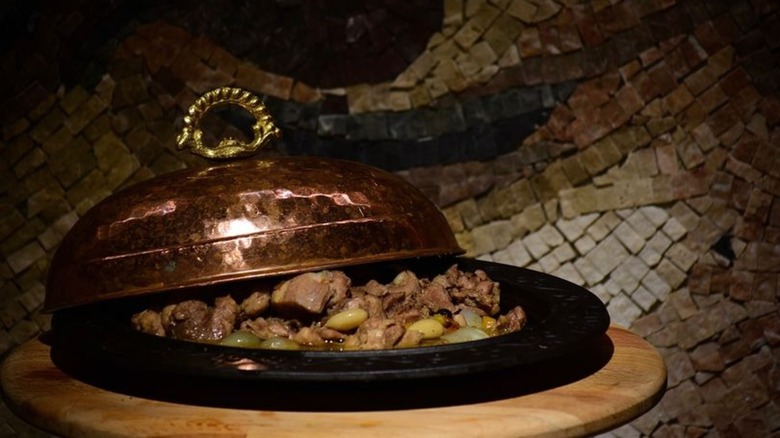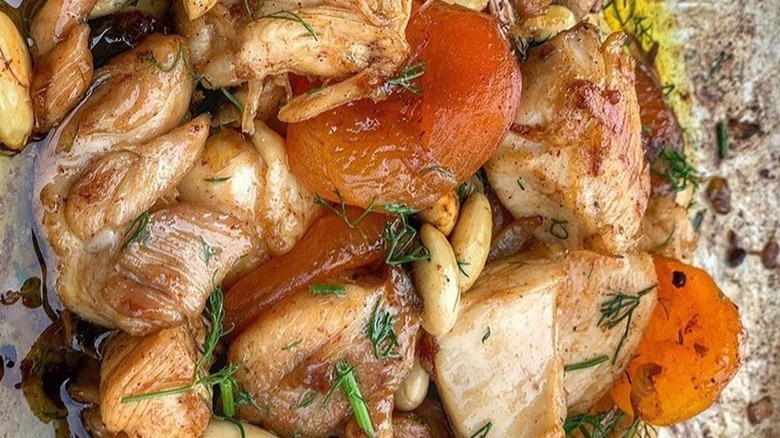Mahmudiye: A Turkish Stew That's Managed To Live On For Hundreds Of Years
Food is the closest thing that we have to a time machine. Dining on meals of yore allows us to share an experience with people who came and went long before our own time. Whether you're aware of it or not, each artichoke you eat connects you to the 1930s Mafia, and every corn chip you dip in salsa was made possible because of the Aztec Empire. The further back in time you go, the more impactful the connection becomes.
By sampling ancient cuisine, we are able to glean some understanding of the triumphs and trials of multiple cultures and classes, whether it's the resourcefulness of the peasantry, who had to make the most of every ingredient, or the opulence of royalty, who reveled in excess. It places you in other people's shoes, some of whom lived a life of grandiosity beyond anything the world knows today, which brings us to mahmudiye — a sweet and savory delicacy, and the closest you will ever come to being Sultan of the Ottoman Empire.
What is mahmudiye?
It's difficult to compare mahmudiye to anything in American cuisine. It's part stew, part casserole, part dinner, and part dessert, and yet none of those descriptors really capture what it tastes like. Mahmudiye is a mixture of chicken, almonds, and apricots baked in a ceramic dish with honey, cinnamon, and lemon juice. Some recipes add other dried fruits such as currants or sultanas. It is a main course typically served alongside rice or, occasionally, orzo. Mahmudiye's unique assortment of ingredients allows you to experience all five tastes in a single dish. The chicken gives you a savory umami base, the honey and apricot add sweetness, lemon juice brings a sour tang, cinnamon lends just a touch of spiced bitterness, and a dash of salt brings it all together.
An outsider might fear that all of these flavors would clash, but the opposite is true. The ingredients are apportioned in just such a way that the five tastes balance each other out. Luxuriant, but not heavy, it's a meal best enjoyed on special occasions. Long before Turkey was known as Turkey, the Sultans of the Ottoman Empire feasted upon mahmudiye in times of celebration, making it a significant part of a now-obscure culinary style known as Ottoman Palace Cuisine.
Ottoman palace cuisine
As noted by The Takeout, Mahmudiye potentially dates back to at least 1539, during the peak centuries of Ottoman power. In that era, the ruling Sultans lived in exceedingly opulent palaces whose vast kitchens were designed to serve hundreds of people. They had separate kitchens that served unique purposes. There was the matbah-ı has, where the Sultan's food was made, and the muzıka-yı hümayun, which made food for his harem. The princes, guards, and servants all had their own dedicated kitchens. Mahmudiye was the kind of dish that you would only expect to see in the kitchen of the Sultan himself, and indeed, many Ottoman rulers cherished it.
The apparent introduction of mahmudiye in 1539 coincided with the rule of Sultan Süleyman I, also known as Süleyman the Magnificent, considered by some to be the empire's greatest ruler. Süleyman reportedly requested the dish at both of his sons' circumcision feasts (royal circumcisions were a big deal and a time for opulent celebration). Mahmudiye was also known to be the favorite food of Sultan Mahmud II, and the dish is said to be named for him. Strangely though, Mahmud II did not begin his reign until 1808, and Mahmud I ruled in the 1700s. Though the dish predates them by centuries, its original name seems to have been lost to history.


